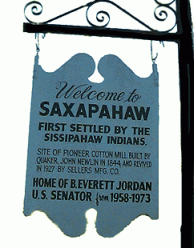Sissipahaw Indians
 In 1701 Englishman John Lawson visited the Sissipahaw town on the Haw River in present-day Alamance County. Believed to have been a Siouan-speaking people, the Sissipahaw were also known as the Saxapahaw, the name by which they are remembered in historical documents. They were so closely associated with the Shakori that some scholars think they may have been one and the same. In 1711, when the Saxapahaw refused to join Tuscarora Chief Hancock's plans to make war on white Carolina settlements, a Tuscarora party attacked them, destroying their town and scattering the people. Some Saxapahaw warriors joined the invading South Carolina army of Col. John Barnwell to fight the Tuscarora, while others may have fled to the Waccamaw. After the Tuscarora War ended in 1713, the Saxapahaw joined with other Indian groups in the Yamassee War. The survivors of that conflict probably then joined the diverse and powerful Catawba Nation.
In 1701 Englishman John Lawson visited the Sissipahaw town on the Haw River in present-day Alamance County. Believed to have been a Siouan-speaking people, the Sissipahaw were also known as the Saxapahaw, the name by which they are remembered in historical documents. They were so closely associated with the Shakori that some scholars think they may have been one and the same. In 1711, when the Saxapahaw refused to join Tuscarora Chief Hancock's plans to make war on white Carolina settlements, a Tuscarora party attacked them, destroying their town and scattering the people. Some Saxapahaw warriors joined the invading South Carolina army of Col. John Barnwell to fight the Tuscarora, while others may have fled to the Waccamaw. After the Tuscarora War ended in 1713, the Saxapahaw joined with other Indian groups in the Yamassee War. The survivors of that conflict probably then joined the diverse and powerful Catawba Nation.
References:
Douglas L. Rights, The American Indian in North America (2nd ed., 1957).
H. Trawick Ward and R. P. Stephen Davis Jr., Indian Communities on the North Carolina Piedmont, A.D. 1000 to 1700 (1993).
Image Credit:
Saxapahaw town marker. Photo courtesy of ibiblio.org. Available from http://www.ibiblio.org/kelly/vnc/alamance/saxapahaw.html (accessed May 23, 2012).
1 January 2006 | Green, Michael D.